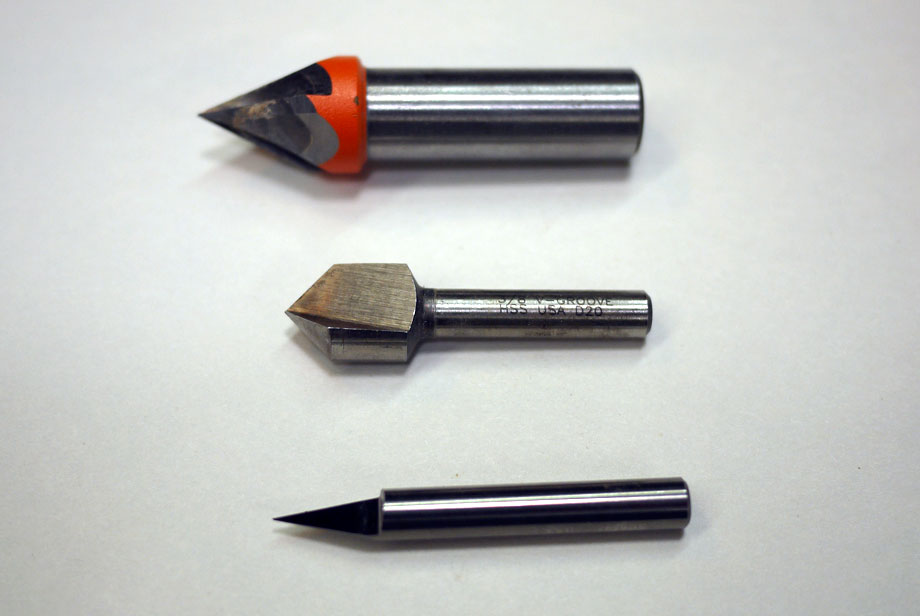CNC Router Bits Demystified
by Greg Flanagan • April 4, 2013 • Resources, shopbot • 6 Comments
CNC routers need bits. They determine the kind of carving you can do, the resolution of your finished designs, and how fast you can move through the material. They come with cutting edges that pull up or push down (sometimes both), they have square or shaped ends, they are made for speed or accuracy, and they come in diameters from a pinpoint to over an inch for standard CNC routing.

- A basic collection of CNC router bits
Confused? Here are some suggestions to get you started.
Common types of bits.

- End mills (aka spiral cutters)
End mills come in many different diameters. You can choose an upcut or downcut. An upcut bit clears the waste out of the cut leaving a cleaner bottom edge, but it pulls up on your material which mean it requires strong clamping. It can also splinter the top surface of material. A downcut bit pushes waste material down into the cut and leaves a cleaner top surface because of the down-shearing cut. You can also choose the number of flutes and the finish the bit will leave. Too much? Don’t worry. I’ve made it easy for you below.

- Ballnose end mill
Ballnose (aka contouring) bits are fantastic for 3d carving (think topographical maps and the grape relief on the sign at the wine shop). You can carve with just the tip to get great detail and smooth contours or they can move a lot of material just like an end mill. I used a 1/2″ ballnose bit to carve a wooden sink.

- v bits
If you want to do lettering or detailed sign making, you’ll need to get a v bit. These are sometimes called v-carving bits, v-groove bits, or engraving bits. This is the only way to get a sharp grooved bottom on the inside of those roman numerals for your sundial. They are available in many sizes and angles. The most common and useful angles in order are 60deg, 90deg, and 30deg.
There are hundreds of other profiles for all kinds of special applications.
Bits you’ll want to have right away.
- 60 degree v bit (lettering and sign carving)
- 1/4″ down cutting 2 fluted end mill (great for general cutting and shaping)
Bits you’ll love to have as you experiment and learn more.
- 30 degree engraving bit (for detailed lettering and carving)
- 1/8″ end mill
- 1/8″ ballnose
- 1/4″ ballnose
- 1/2″ end mill
- 1/2″ ballnose
…and a few specialty bits you might need on occasion.
- aluminum cutting bits
- miter fold bits
- Boring (hole drilling) bits – in specific diameters for dowel holes, shelf supports, and many other uses.
- Round-over and “veining” bits to produce finished edges.
Start with the basics and find what works for you.

Thanks for the advice for a brand new cnc owner. This was exactly the info I was looking for. Thanks for taking the time.
-Rick
Thanks greg been looking for this info since i bought my cnc router
Can you do more articles on bits, and maybe their cuts and looks on different materials.
thanks~~ Good article
Hi, You’ll find more infomation of this type at ShopBotTools.com
Thanks- helps with my shopping list for my new cnc
This is perfect for my novice level of knowledge.
Thanks.